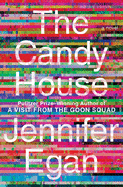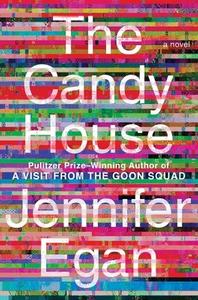
 After she won the Pulitzer Prize and a National Book Critics Circle Award in 2011 for A Visit from the Goon Squad, a novel that focused on the business of pop music and the inexorable passage of time, Jennifer Egan shifted in a more conventional direction with Manhattan Beach, a crime thriller set in the Brooklyn Navy Yard during World War II. Now, in The Candy House, she returns to the stylistic brio and edgier substance of Goon Squad with a novel that revives many of the characters of its literary soulmate while using them to explore a set of fresh and compelling themes.
After she won the Pulitzer Prize and a National Book Critics Circle Award in 2011 for A Visit from the Goon Squad, a novel that focused on the business of pop music and the inexorable passage of time, Jennifer Egan shifted in a more conventional direction with Manhattan Beach, a crime thriller set in the Brooklyn Navy Yard during World War II. Now, in The Candy House, she returns to the stylistic brio and edgier substance of Goon Squad with a novel that revives many of the characters of its literary soulmate while using them to explore a set of fresh and compelling themes.
In chapters that function both as discrete stories and devices that subtly link the lives of a handful of recurring characters, The Candy House ranges over more than seven decades, beginning in the mid-1960s. Egan conjures an unsettling but clearly plausible next stage of social media, where Internet visionary Bix Bouton invents a "memory externalization device" he calls the Mandala Cube, which allows individuals to upload and store a lifetime of memories in mere hours. If they choose, they can share those recollections with the "Collective Consciousness," granting them "proportionate access to the anonymous thoughts and memories of everyone in the world, living or dead, who had done the same."
But as Egan recognizes, "knowing everything is too much like knowing nothing; without a story it's all just information." As she travels forward and backward in time, her stories reveal what is lost in the embrace of this new technology. Pitted against those who welcome it is an "invisible army of data defiers" known as "eluders" who resist its allure. Egan deeply understands what it means to live in a world whose inhabitants are both hyperconnected and atomized, a reality that's only been exaggerated since the onset of the coronavirus pandemic in 2020. "Human beings are unknowable," she writes, "hence the Faustian allure of consciousness sharing."
In employing diverse voices and a variety of narrative styles, Egan displays here the same assurance that propelled Goon Squad. "Lulu the Spy, 2032," for example, is presented in the form of a terse instruction manual to a "Citizen Agent" involved in a dangerous espionage mission. In its aftermath, Lulu reappears in "See Below," a chapter narrated entirely in e-mails. In other chapters, Egan shifts from more conventional third- to first-person voices with ease.
The Candy House holds a mirror up to contemporary society while simultaneously casting a skeptical eye on a future that may already be here. Readers who delighted in the ingenuity of A Visit from the Goon Squad will luxuriate in this novel's Easter eggs and the many plot elements and character appearances that echo across the novel's pages to forge connections over time and space, making the urge to reread it immediately almost irresistible. While its sensibility is coolly observant, at its center is a warm, strongly beating heart. --Harvey Freedenberg, freelance reviewer
Shelf Talker: Jennifer Egan paints an unsettling portrait of life in a near future in which the sharing of consciousness becomes possible.

